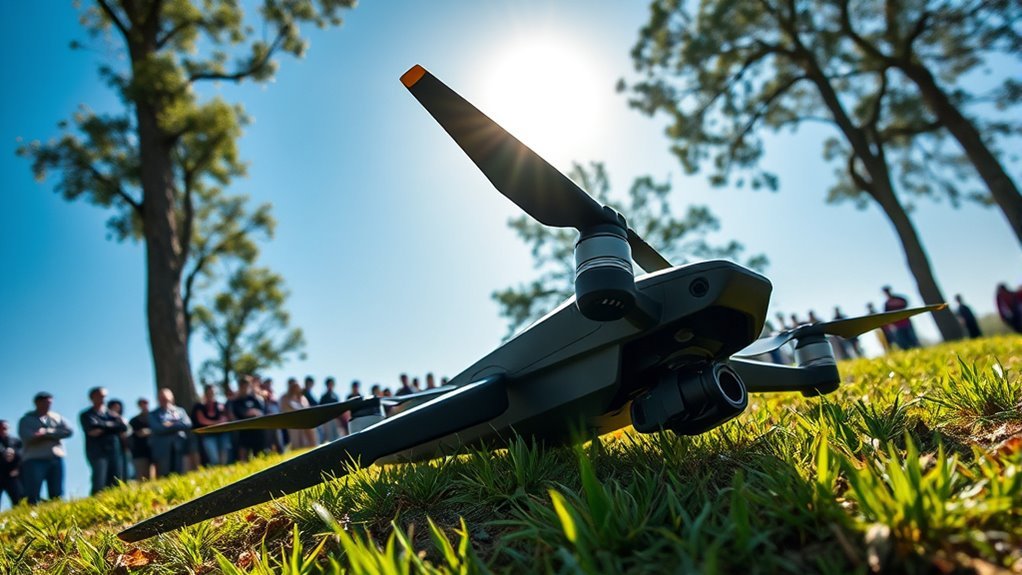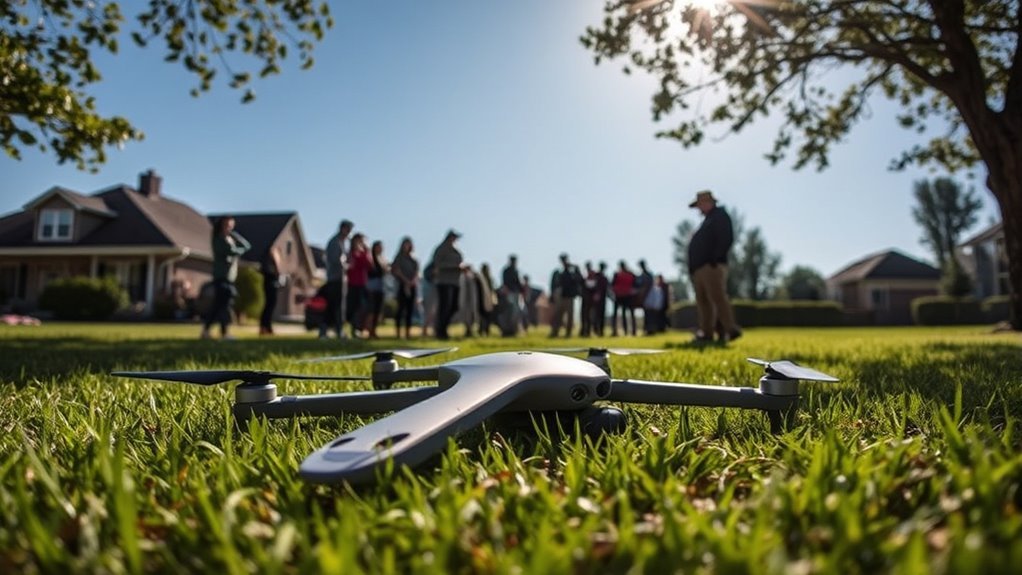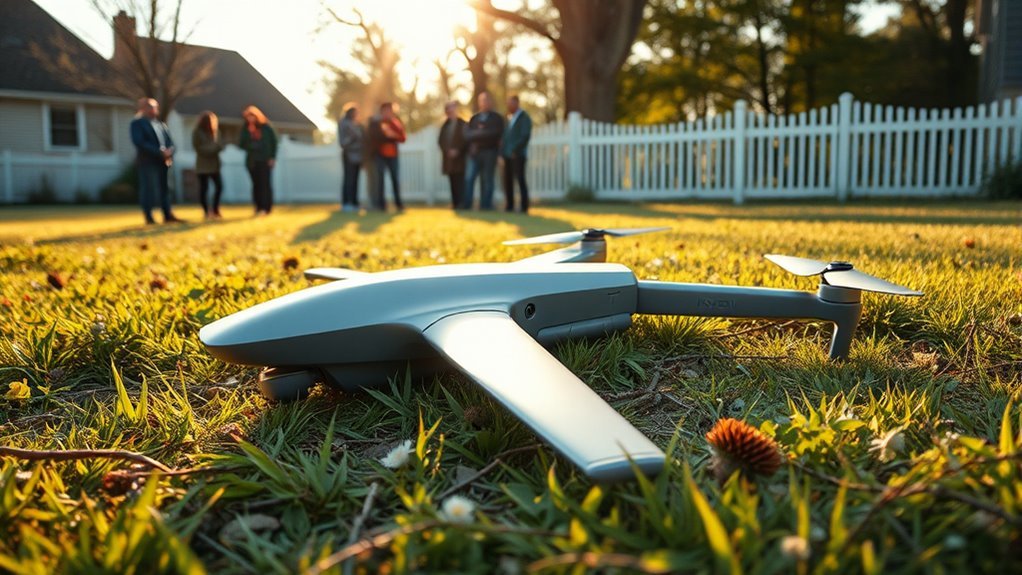Yes, a drone crash occurred recently in New Jersey, raising questions about drone safety and regulation. Eyewitnesses reported erratic behavior prior to the crash, and authorities are investigating pilot error, technical issues, and environmental factors. As regulations evolve to address increasing drone use, the implications for urban operations are significant. There’s a call for community dialogue and responsible drone use that could shape future policies—what else could this incident reveal about our growing reliance on drone technology?
Overview of the Incident

While many might think drones are simply tools for photography or recreation, a recent incident in New Jersey has raised questions about their safety and regulation. Different drone types—ranging from small hobbyist models to larger commercial units—were involved in this event, prompting discussions about their operational limits. Investigators are looking into the incident causes, which may include pilot error, technical malfunctions, or environmental factors. As drone usage continues to grow, the implications of such incidents become significant. How can regulations evolve to guarantee safety while maintaining the freedom that drone enthusiasts cherish? This incident serves as a reminder that understanding the balance between innovation and safety is vital as the drone landscape continues to develop.
Eyewitness Accounts and Social Media Reactions

As investigations into the drone incident in New Jersey unfold, eyewitness accounts and social media reactions are surfacing, providing a window into public perception and concerns. You might wonder how these eyewitness experiences shape the narrative. Some individuals describe seeing a drone behaving erratically before it allegedly crashed, while others question whether it was indeed a drone or something else entirely. Social media reactions reveal a mix of skepticism and alarm, with users sharing videos, photos, and theories. Are these responses fostering a sense of community vigilance, or are they contributing to unwarranted panic? The blend of firsthand accounts and online chatter raises important questions about the reliability of information in our digital age and the implications for public safety and awareness.
Official Statements From Authorities

Amid the swirling speculation surrounding the drone crash in New Jersey, authorities have begun to release official statements aimed at clarifying the situation. You might be wondering how these authority responses shape public understanding. The statements emphasize an ongoing investigation, seeking to gather facts rather than fuel rumors. They confirm that no injuries occurred and urge the community to remain calm while they assess the situation. It’s clear that transparency is a priority, as they encourage anyone with information to come forward. However, the lack of detailed explanations leaves many questions unanswered. As you analyze these official statements, consider how they reflect the balance between public safety and the need for information in a time of uncertainty.
The Role of Drone Technology in Urban Areas
As urban areas grow, how do you see drone technology reshaping surveillance and delivery services? With potential benefits come significant regulatory challenges that cities must address. What implications do these factors have for the future of urban living? Additionally, cities may need to consider supply chain disruptions as they integrate drone technology, ensuring a reliable infrastructure for these services. The integration of advanced AI solutions could enhance the efficiency of urban drone operations, allowing for smarter navigation and improved response times in dynamic environments.
Urban Surveillance Applications
While urban landscapes become increasingly complex, the integration of drone technology for surveillance purposes is capturing attention. You might wonder how this impacts your daily life, especially concerning drone privacy. Here are some urban monitoring applications worth considering:
- Traffic Management: Drones can monitor congestion and accidents in real-time.
- Public Safety: They assist in crime prevention and emergency response.
- Environmental Monitoring: Drones can track pollution levels and urban heat islands.
- Event Surveillance: They provide aerial views for large gatherings, ensuring safety.
As these technologies evolve, how will they balance the benefits of enhanced urban monitoring against the potential threats to individual privacy? It’s a question that demands careful thought as drones become more prevalent in our cities.
Delivery Services Integration
With the rise of e-commerce and consumer demand for faster delivery, drone technology is increasingly being integrated into urban logistics. You might wonder how this shift impacts our daily lives and the efficiency of delivery systems.
| Aspect | Drone Logistics |
|---|---|
| Speed | Rapid delivery to your doorstep |
| Cost Efficiency | Lower operational costs |
| Accessibility | Reach remote or congested areas |
| Environmental Impact | Reduced carbon footprint |
As you explore the implications, consider how drone logistics can revolutionize urban environments. Could they alleviate traffic congestion and provide convenience? Or do they raise concerns about airspace and noise pollution? Your perspective on these innovations shapes the future of delivery systems in cities.
Regulatory Challenges Ahead
The integration of drone technology into urban logistics brings not only opportunities but also a host of regulatory challenges. As you explore this new frontier, you might wonder how regulatory frameworks can keep pace with innovation. Here are four key compliance challenges you should consider:
- Airspace Management: Who controls the skies? Balancing drone flights with manned aircraft is vital.
- Privacy Concerns: How do we protect personal privacy while allowing drones to operate freely?
- Safety Regulations: What standards guarantee drones don’t pose risks to people and property?
- Insurance and Liability: Who’s responsible when things go wrong?
Navigating these complexities will be imperative for the successful deployment of drone technology in urban areas. Are we ready for this shift?
Safety Regulations Surrounding Drones
As drone technology rapidly evolves, understanding the safety regulations that govern their use becomes increasingly vital. You might wonder how these regulations impact your freedom to operate drones. Fundamentally, drone safety isn’t just about avoiding crashes; it also involves regulatory compliance with guidelines set by organizations like the FAA. These regulations guarantee that you’re flying responsibly, protecting not only your interests but also those of others. Are you aware of the restrictions regarding altitude, no-fly zones, or the requirement for registration? Ignoring these rules could lead to serious consequences, including fines or damage to your reputation. As you explore the skies with your drone, staying informed about safety regulations will empower you to enjoy this freedom responsibly and legally. Additionally, understanding drone registration requirements is crucial for legal compliance and safety assurance. Always remember to check for temporary flight restrictions before your flights to ensure compliance with local laws.
Implications for Future Drone Use and Policy
While many enthusiasts embrace the benefits of drone technology, the recent incidents, like the drone crash in NJ, raise critical questions about the future of drone use and policy. To navigate these challenges, we need to contemplate:
- Drone Ethics: How can we guarantee responsible use that respects privacy and safety? Incorporating advanced data encryption can help ensure that sensitive information is protected during drone operations.
- Public Perception: What steps can we take to improve public trust in drone technology?
- Regulatory Frameworks: How should laws evolve to balance innovation and safety?
- Community Engagement: In what ways can we involve the public in shaping drone policies?
As you ponder these implications, it’s crucial to recognize that the future of drones hinges on our collective approach to ethics and public sentiment. Moreover, integrating proactive vulnerability identification will be essential in ensuring the safety and security of drone operations.
Frequently Asked Questions
What Type of Drone Was Involved in the Crash?
What type of drone was involved in the crash? You might want to reflect on how various drone technologies comply with flight regulations. Analyzing the specifics can reveal insights into safety standards and operational compliance within the industry.
Were There Any Injuries Reported From the Incident?
You might wonder if there were any injury reports related to the incident. Analyzing drone safety protocols can provide insight into potential risks, and it’s essential to stay informed about any developments that affect public safety.
What Time Did the Drone Crash Occur?
When the clock strikes chaos, you might wonder what time the drone crashed. It’s vital to know, as drone regulations and the ongoing crash investigation could shed light on safety measures and prevent future incidents.
Who Owns the Crashed Drone?
Who owns the crashed drone? You might consider drone regulations, as ownership disputes often arise. Investigating whether it was registered could clarify ownership, highlighting the importance of understanding the legal frameworks governing personal drone usage.
Has This Happened Before in New Jersey?
You wouldn’t believe how often drones have had mishaps in New Jersey! With evolving drone regulations and flight safety concerns, it’s essential to analyze past incidents to guarantee safer skies for everyone. What do you think?

